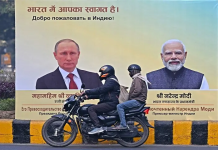Vidin, Bulgaria, March 28 (AFP/APP):When Bulgaria and Romania partially join Europe’s Schengen zone on Sunday after more than a decade of negotiations, hundreds of weary long-haul drivers like Anton Antonov won’t have much to celebrate as land border controls won’t be disappearing.
The 48-year-old Bulgarian and other drivers will continue facing long queues at the congested Vidin-Calafat border post separating the two Balkan countries, which are only opening up travel by air and sea with Schengen nations.
“On this crossing, it’s always a wait of a minimum of seven to eight hours” before truckers can cross the Danube river via the “New Europe” bridge, Antonov told AFP at dawn after having spent the night sleeping in his cabin while waiting in the kilometre-long queue on the Bulgarian side.
A lack of parking spaces, proper toilets and showers turns those long waits into nerve-wracking ordeals for truck drivers and slow down trade with the rest of Europe.
The hopes of EU members Bulgaria and Romania to fully join the Schengen zone were dashed by Austria, which finally relented in December about allowing them to join by air and sea from March 31.
Croatia, which joined the EU after Romania and Bulgaria, even beat them to the punch in January 2023 by becoming Schengen’s 27th member.
Created in 1985, the vast visa-free zone includes 23 of the 27 EU member states as well as Switzerland, Norway, Iceland and Liechtenstein.
Austria continues to oppose fully expanding Schengen to Bulgaria and Romania even though it does not share a land border with them. It fears migrants gaining entry to both countries would then be able to travel unimpeded to claim asylum in other nations.
But some experts say that Austria’s concerns might be driven by political motives as the Alpine country faces elections in the autumn, with the far-right FPOe party currently leading in the polls.
The Netherlands, which had also thwarted Sofia’s Schengen bid, dropped its objection in December, endorsing “Bulgaria’s full application” to the zone.
Bulgaria and Romania both hope to fully integrate into Schengen by the end of the year, although the latest political crisis in Sofia could derail its chances and also frustrate its hopes to adopt the euro next year.
Full entry couldn’t come soon enough for Latvian truck driver Gediminas Gostautas.
“Partial Schengen does not make life easier for me at all,” he groused while preparing lunch on a gas cooker stove inside his truck cabin to shelter from the cold wind outside.
“You lose a minimum of 24 hours waiting at the two border crossings of Bulgaria-Romania and Romnia-Hungary,” said Gostautas, 42.
According to international hauliers associations, 92 percent of Bulgarian exports to the EU transit by land, mainly via trucks and to a lesser extent by rail. The end of land border controls would not only speed transit, but reduce trucking costs, providing a much needed economic boost.
It will also speed transit of goods to and from neighbouring Turkey, a major EU trading partner.
Measures like travelling at night when most drivers sleep, frequently consulting Google Maps or checking in with colleagues who are already queueing can reduce waiting hours, but the time saved is marginal.
Moreover, truckers still need to respect mandatory rest periods after nine hours per day behind the wheel.
Since drivers are prohibited from moving their vehicles during rest times, many place a high-visibility vest on the back of their trucks to let others know that they can overtake, further impeding the traffic flow, Gostautas explained.
And drivers need to remain vigilant during breaks on the road as migrants might try to take advantage of a stop to hide in the trucks’ compartments.
“I hope that later this year, God willing, we’ll also join (Schengen) by land and cross borders like in western Europe, only seeing Welcome signs,” Antonov said while climbing back into his cabin.
Meanwhile, the queue has moved on by about 20 metres before it once again grinds to a halt.

















